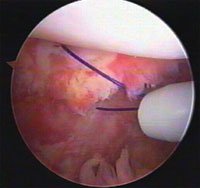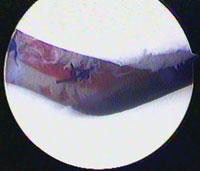Surgeon offers tips and tricks for approaching cases of patella instability
At Orthopedics Today Hawaii 2012, John D. Kelly IV, MD, discussed methods to address patella instability including whether to use proximal or distal re-alignment and the indications for medial patellofemoral ligament reconstruction.
In many cases of patella instability, Kelly noted there is usually one principle problem that requires the most attention. This can be bone or soft tissue issues, patella problems, dysplasia or a problematic Q angle. He said that surgeons should consider the following principles when examining for instability:
- If it is not broke, do not fix it;
- There is no universal magic bullet to patella instability;
- Do your best to fix the principle problem; and
- Patella problems are a continuum. Bigger problems require bigger solutions.
Good indications of a bony problem may be a 20° Q angle at 30° flexion and mimicry of a CT scan with tibial tubercle-trochlear groove (TT-TG) distance.
“Do not forget your lateral X-ray,” Kelly, an associate professor of orthopedic surgery at the University of Pennsylvania, said. “The French have taught us a lot about a simple lateral X-ray demonstrating trochlear dysplasia and patella tilt.”
Consider the medial patellofemoral ligament (MPFL), lateral retinaculum or vastus medialis oblique (VMO) when examining soft tissue.


The Halbrecht procedure is performed as shown in these preoperative (left) and postoperative (right) MPFL images.
Images: Kelly JD
He noted that the MPFL is the primary restraint and the lateral retinaculum is a stabilizer to patella instability.
“Release the retinaculum, [and the] patella requires less force to get up and over the hill – lateral trochlea,” Kelly said. “If you cut it, the forces required for the patella to translate laterally are usually lessened. Tightness leads to tilt, not subluxation.”
For soft tissue problems, the options are advancing the VMO, medial imbrication, MPFL repair or MPFL reconstruction. For bony problems, the choices include medialization of the tubercle, the Fulkerson procedure or trochleoplasty, which Kelly said is not indicated in his opinion.
“I think VMO advancement has really kind of fallen out of favor,” Kelly said. He said the open reefing technique “makes things tight,” but the technique is nonisometric. Kelly prefers to use the Halbrecht procedure – arthroscopic plication of the MPFL.
“I think this works great because the MPFL, when it does tear, it does tend to heal, albeit elongated. This [technique] is not difficult to do,” he said.
The technique works best when there is excessive lateral glide, good tissue and a Q angle of 15° or less when flexing the knee to 20°.
“I have learned the best way for me to do this is to look from [the] inferior lateral portal,” Kelly said.
“MPFL reconstruction, the role is evolving,” Kelly said. He noted indications for MPFL reconstruction include a failed distal re-alignment, profound trochlear dysplasia with a normal Q angle or poor medial tissue with chondrosis in a varus knee.
“The MPFL tightens in the first 30° of flexion. It is lax with increasing flexion and do not forget, it is a check rein,” Kelly said. “You are not supposed to pull the patella medially. If you do that, you are going to create some problems. Further, if tubercle malalignment is not addressed, even in the presence of MPFL reconstruction, you will have persistent lateral translation and lateral subluxation.” – by Renee Blisard
References:
- Kelly JD IV. Patella instability: Proximal vs. distal re-alignment? Indications for MPFL reconstruction. Presented at Orthopedics Today Hawaii 2012, Jan. 15-18. Wailea, Hawaii.
- Halbrecht JL. Arthroscopic patella realignment: An all-inside technique. Arthroscopy. 2001; 17(9):940-945.
For more information:
- John D. Kelly IV, MD, can be reached at the Department of Sports Medicine, University of Pennsylvania, 235 S. 33rd St., Philadelphia, PA 19104; 215-615-4400; email: johndkellyiv@aol.com.
- Disclosure: Kelly has no relevant financial disclosures.




